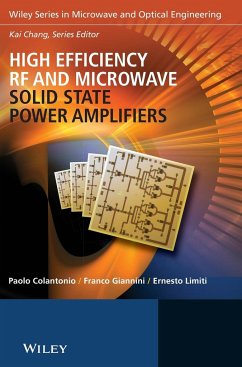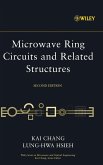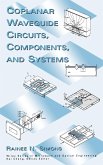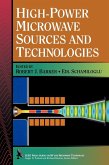Paolo Colantonio, Franco Giannini, Ernesto Limiti
High Efficiency RF and Microwave Solid State Power Amplifiers
Paolo Colantonio, Franco Giannini, Ernesto Limiti
High Efficiency RF and Microwave Solid State Power Amplifiers
- Gebundenes Buch
- Merkliste
- Auf die Merkliste
- Bewerten Bewerten
- Teilen
- Produkt teilen
- Produkterinnerung
- Produkterinnerung
This book is a comprehensive reference on the design of high efficiency and high frequency solid state power amplifiers (SSPAs). The authors cover fundamental theory on power amplifiers, as well as presenting practical techniques and examples, discussing the pros and cons for each design method. They also recapitulate topics and techniques that are often misused or misunderstood in the field of SSPA, such as bias classes or nomenclatures, and examine both hybrid and monolithic microwave integrated circuit (MMIC) design approaches, highlighting design guidelines and criteria. The book ends with…mehr
Andere Kunden interessierten sich auch für
![RF and Microwave Wireless Systems RF and Microwave Wireless Systems]() Kai ChangRF and Microwave Wireless Systems197,99 €
Kai ChangRF and Microwave Wireless Systems197,99 €![Microwave Ring Circuits and Related Structures Microwave Ring Circuits and Related Structures]() Kai ChangMicrowave Ring Circuits and Related Structures302,99 €
Kai ChangMicrowave Ring Circuits and Related Structures302,99 €![Autonomous Microwave Circuits Autonomous Microwave Circuits]() Almudena SuarezAutonomous Microwave Circuits220,99 €
Almudena SuarezAutonomous Microwave Circuits220,99 €![Introduction to Electromagnetic and Microwave Engineering Introduction to Electromagnetic and Microwave Engineering]() Paul R. KarmelIntroduction to Electromagnetic and Microwave Engineering239,99 €
Paul R. KarmelIntroduction to Electromagnetic and Microwave Engineering239,99 €![Fundamentals of RF and Microwave Transistor Amplifiers Fundamentals of RF and Microwave Transistor Amplifiers]() Inder BahlFundamentals of RF and Microwave Transistor Amplifiers208,99 €
Inder BahlFundamentals of RF and Microwave Transistor Amplifiers208,99 €![Coplanar Waveguide Circuits, Components, and Systems Coplanar Waveguide Circuits, Components, and Systems]() Rainee N. SimonsCoplanar Waveguide Circuits, Components, and Systems194,99 €
Rainee N. SimonsCoplanar Waveguide Circuits, Components, and Systems194,99 €![High-Power Microwave Sources and Technologies High-Power Microwave Sources and Technologies]() Robert J. Barker / Edl Schamiloglu (Hgg.)High-Power Microwave Sources and Technologies259,99 €
Robert J. Barker / Edl Schamiloglu (Hgg.)High-Power Microwave Sources and Technologies259,99 €-
-
-
This book is a comprehensive reference on the design of high efficiency and high frequency solid state power amplifiers (SSPAs). The authors cover fundamental theory on power amplifiers, as well as presenting practical techniques and examples, discussing the pros and cons for each design method. They also recapitulate topics and techniques that are often misused or misunderstood in the field of SSPA, such as bias classes or nomenclatures, and examine both hybrid and monolithic microwave integrated circuit (MMIC) design approaches, highlighting design guidelines and criteria. The book ends with a case study on designing power amplifiers (PAs) for modern communication systems, introducing the reader to the use of PAs in actual systems and describing advanced techniques based on architecture solutions to improve PA performance.
Presents comprehensive information on the optimum design of high efficiency and high frequency solid state power amplifiers (SSPAs), essential for the efficient management of power supply in all modern communication systems.
Provides an overview of the main theoretical concepts in amplifier design, clarifying fundamental topics which are often misunderstood and misused such as bias classes and PA nomenclatures.
Considers both hybrid and monolithic microwave integrated circuits (MMICs), highlighting the design guidelines and criteria.
Sets out practical techniques for high efficiency microwave power amplifier design, stating the pros and cons for each method and giving running examples and case studies.
Ideal for Sc and postgraduate students taking courses in microwave electronics and solid state circuit/device design as well as practising electronics engineers and researchers in the field of power amplifier design and microwave and RF engineering.
Presents comprehensive information on the optimum design of high efficiency and high frequency solid state power amplifiers (SSPAs), essential for the efficient management of power supply in all modern communication systems.
Provides an overview of the main theoretical concepts in amplifier design, clarifying fundamental topics which are often misunderstood and misused such as bias classes and PA nomenclatures.
Considers both hybrid and monolithic microwave integrated circuits (MMICs), highlighting the design guidelines and criteria.
Sets out practical techniques for high efficiency microwave power amplifier design, stating the pros and cons for each method and giving running examples and case studies.
Ideal for Sc and postgraduate students taking courses in microwave electronics and solid state circuit/device design as well as practising electronics engineers and researchers in the field of power amplifier design and microwave and RF engineering.
Produktdetails
- Produktdetails
- Wiley Series in Microwave and Optical Engineering
- Verlag: Wiley & Sons
- Artikelnr. des Verlages: 14551300000
- 1. Auflage
- Seitenzahl: 528
- Erscheinungstermin: 1. September 2009
- Englisch
- Abmessung: 250mm x 175mm x 32mm
- Gewicht: 1005g
- ISBN-13: 9780470513002
- ISBN-10: 0470513004
- Artikelnr.: 26556386
- Wiley Series in Microwave and Optical Engineering
- Verlag: Wiley & Sons
- Artikelnr. des Verlages: 14551300000
- 1. Auflage
- Seitenzahl: 528
- Erscheinungstermin: 1. September 2009
- Englisch
- Abmessung: 250mm x 175mm x 32mm
- Gewicht: 1005g
- ISBN-13: 9780470513002
- ISBN-10: 0470513004
- Artikelnr.: 26556386
Paolo Colantonio was born in Rome on March 1969 and he received Electronic Engineering and Ph.D degrees in Microelectronics and Telecommunications from the University of Roma 'Tor Vergata' in 1994 and 2000 respectively, working on design criteria for high efficiency power amplifiers. In 1999 he became a research assistant at the Electronic Engineering Department of the University of Roma 'Tor Vergata' and since 2002 he has been a professor of microwave electronics at the same university. His research activities are mainly focused on the field of microwave and millimetre-wave electronics, and in particular on design criteria for nonlinear microwave subsystems. This activity resulted in the development of innovative design criteria for high efficiency and high linear power amplifiers, oriented to the optimization of power performance making use of harmonic tuning classes of operation. The results of such activities have been presented in major conferences and ublished in international journals. Paolo Colantonio has been responsible for the work package activity on 'power amplifier design overview' in the VI-FP European Network of Excellence TARGET (January 2004-June 2005) and general chairman of the international event 'First TARGET NoE Workshop on RF Power Amplifiers', held in Orvieto, Italy 2005. He is author or co-author of more than 120 papers on PA design published in refereed journals or international conference proceedings and he has been awarded Best Poster Paper at GAAS 2000 (IMD performances of harmonically tuned microwave power amplifiers) and Best Paper at EuMIC 2007 (A 6W Uneven Doherty Power Amplifier in GaN Technology). Franco Giannini was born in Galatina (LE), on November 9, 1944, and graduated in Electronics Engineering, summa cum laude in 1968, before getting the chair of Full Professor of Applied Electronics in 1980. In 2008 he was awarded the Laurea Honoris Causa Scientiarum Technicarum degree by the Warsaw University of Technology (WUT), Poland. Since 1981 he has been at the University of Roma 'Tor Vergata', where he has been serving as Head of Department, Vice President for International Affairs, Pro-Rector, and Dean of the Faculty of Electronics Engineering. He presently chairs theMicrowave Engineering Centre for Space Applications (MECSA). He has been working on modelling, characterization and design methodologies of active and passive microwave components and circuits, including MICs and MMICs for telecommunication and space applications, authoring or co-authoring more than 400 scientific contributions. He chaired the theme MMICs of the national project MADESS I of the CNR and was a member of the Management Board of MADESS II, chairman of the theme MMICs of the National Project MICROELECTRONICS, and member of the Board of Directors of the Italian Space Agency (ASI). He has also been active in many European Projects, and was the Italian representative in the 'European Working Group for GaAs Microelectronics'. He has been acting as consultant for various national and international organizations, including the ITU for the United Nations Development Program (UNDP), and the European Union for ESPRIT, LTR, ISTC projects. He has been chairman of various International Symposia on Microwave & MillimetreWave Techniques and is a member of many committees of international scientific conferences. In 1996 Professor Giannini was awarded the 'Irena Galewska Kielbasinski Prize' by the Technical University of Darmstadt, Germany, and an Honorary Professorship by WUT, Poland, in 2001. Ernesto Limiti has been Full Professor of Electronics at the University of Roma 'Tor Vergata' since 2002, after being associate professor and researcher at the same university since 1991. He teaches undergraduate courses in microwave electronics, namely Microwave Electronics (basic) andMicrowave Instrumentation and Measurements, all of them at the LaureaMagistrale in the Electronic Engineering degree course (i.e. towards students with at least three years experience at the university). He also teaches MSc and PhD courses, both at the University of Roma 'Tor Vergata' and at other Italian universities. His scientific interests encompass a broad range of topics, including microwave active device characterization and modelling, regarding both linear (small-signal and noise) and nonlinear regimes and microwave subsystems design methodologies. Regarding the latter, high efficiency power amplifier design methodologies have been his focus since 1992, oriented towards power performance optimization making use of harmonic tuning operating classes. This research topic has been investigated also in the frame of European research projects, e.g. Manpower, Edge, and others. The results on the work in high efficiency power amplifier design approaches have been presented in major conferences and published in international journals. Ernesto Limiti is author or co-author of more than 200 papers appearing in refereed journals or international conference proceedings. He is a member of the Editorial Board of the International Journal of Microwave and Millimetre-Wave CAE (Wiley Interscience), serving also as a reviewer for various IEEE Transactions and IET Journals. He has been general chairman and organizer of the 2004 international workshop on Integrated Nonlinear Microwave and Millimetre-wave Circuits (INMMiC 2004) as well as the 11th International Symposium on Microwave and Optical Technology (ISMOT 2007).
Preface. About the Authors. Acknowledgments. 1 Power Amplifier
Fundamentals. 1.1 Introduction. 1.2 Definition of Power Amplifier
Parameters. 1.3 Distortion Parameters. 1.4 Power Match Condition. 1.5 Class
of Operation. 1.6 Overview of Semiconductors for PAs. 1.7 Devices for PA.
1.8 Appendix: Demonstration of Useful Relationships. 1.9 References. 2
Power Amplifier Design. 2.1 Introduction. 2.2 Design Flow. 2.3 Simplified
Approaches. 2.4 The Tuned Load Amplifier. 2.5 Sample Design of a Tuned Load
PA. 2.6 References. 3 Nonlinear Analysis for Power Amplifiers. 3.1
Introduction. 3.2 Linear vs. Nonlinear Circuits. 3.3 Time Domain
Integration. 3.4 Example. 3.5 Solution by Series Expansion. 3.6 The
Volterra Series. 3.7 The Fourier Series. 3.8 The Harmonic Balance. 3.9
Envelope Analysis. 3.10 Spectral Balance. 3.11 Large Signal Stability
Issue. 3.12 References. 4 Load Pull. 4.1 Introduction. 4.2 Passive
Source/Load Pull Measurement Systems. 4.3 Active Source/Load Pull
Measurement Systems. 4.4 Measurement Test-sets. 4.5 Advanced Load Pull
Measurements. 4.6 Source/Load Pull Characterization. 4.7 Determination of
Optimum Load Condition. 4.8 Appendix: Construction of Simplified Load Pull
Contours through Linear Simulations. 4.9 References. 5 High Efficiency PA
Design Theory. 5.1 Introduction. 5.2 Power Balance in a PA. 5.3 Ideal
Approaches. 5.4 High Frequency Harmonic Tuning Approaches. 5.5 High
Frequency Third Harmonic Tuned (Class F). 5.6 High Frequency Second
Harmonic Tuned. 5.7 High Frequency Second and Third Harmonic Tuned. 5.8
Design by Harmonic Tuning. 5.9 Final Remarks. 5.10 References. 6 Switched
Amplifiers. 6.1 Introduction. 6.2 The Ideal Class E Amplifier. 6.3 Class E
Behavioural Analysis. 6.4 Low Frequency Class E Amplifier Design. 6.5 Class
E Amplifier Design with 50% Duty-cycle. 6.6 Examples of High Frequency
Class E Amplifiers. 6.7 Class E vs. Harmonic Tuned. 6.8 Class E Final
Remarks. 6.9 Appendix: Demonstration of Useful Relationships. 6.10
References. 7 High Frequency Class F Power Amplifiers. 7.1 Introduction.
7.2 Class F Description Based on Voltage Wave-shaping. 7.3 High Frequency
Class F Amplifiers. 7.4 Bias Level Selection. 7.5 Class F Output Matching
Network Design. 7.6 Class F Design Examples. 7.7 References. 8 High
Frequency Harmonic Tuned Power Amplifiers. 8.1 Introduction. 8.2 Theory of
Harmonic Tuned PA Design. 8.3 Input Device Nonlinear Phenomena: Theoretical
Analysis. 8.4 Input Device Nonlinear Phenomena: Experimental Results. 8.5
Output Device Nonlinear Phenomena. 8.6 Design of a Second HT Power
Amplifier. 8.7 Design of a Second and Third HT Power Amplifier. 8.8 Example
of 2nd HT GaN PA. 8.9 Final Remarks. 8.10 References. 9 High Linearity in
Efficient Power Amplifiers. 9.1 Introduction. 9.2 Systems Classification.
9.3 Linearity Issue. 9.4 Bias Point Influence on IMD. 9.5 Harmonic Loading
Effects on IMD. 9.6 Appendix: Volterra Analysis Example. 9.7 References. 10
Power Combining. 10.1 Introduction. 10.2 Device Scaling Properties. 10.3
Power Budget. 10.4 Power Combiner Classification. 10.5 The T-junction Power
Divider. 10.6 Wilkinson Combiner. 10.7 The Quadrature (90º) Hybrid. 10.8
The 180º Hybrid (Ring Coupler or Rat-race). 10.9 Bus-bar Combiner. 10.10
Other Planar Combiners. 10.11 Corporate Combiners. 10.12 Resonating Planar
Combiners. 10.13 Graceful Degradation. 10.14 Matching Properties of
Combined PAs. 10.15 Unbalance Issue in Hybrid Combiners. 10.16 Appendix:
Basic Properties of Three-port Networks. 10.17 References. 11 The Doherty
Power Amplifier. 11.1 Introduction. 11.2 Doherty's Idea. 11.3 The Classical
Doherty Configuration. 11.4 The 'AB-C' Doherty Amplifier Analysis. 11.5
Power Splitter Sizing. 11.6 Evaluation of the Gain in a Doherty Amplifier.
11.7 Design Example. 11.8 Advanced Solutions. 11.9 References. Index.
Fundamentals. 1.1 Introduction. 1.2 Definition of Power Amplifier
Parameters. 1.3 Distortion Parameters. 1.4 Power Match Condition. 1.5 Class
of Operation. 1.6 Overview of Semiconductors for PAs. 1.7 Devices for PA.
1.8 Appendix: Demonstration of Useful Relationships. 1.9 References. 2
Power Amplifier Design. 2.1 Introduction. 2.2 Design Flow. 2.3 Simplified
Approaches. 2.4 The Tuned Load Amplifier. 2.5 Sample Design of a Tuned Load
PA. 2.6 References. 3 Nonlinear Analysis for Power Amplifiers. 3.1
Introduction. 3.2 Linear vs. Nonlinear Circuits. 3.3 Time Domain
Integration. 3.4 Example. 3.5 Solution by Series Expansion. 3.6 The
Volterra Series. 3.7 The Fourier Series. 3.8 The Harmonic Balance. 3.9
Envelope Analysis. 3.10 Spectral Balance. 3.11 Large Signal Stability
Issue. 3.12 References. 4 Load Pull. 4.1 Introduction. 4.2 Passive
Source/Load Pull Measurement Systems. 4.3 Active Source/Load Pull
Measurement Systems. 4.4 Measurement Test-sets. 4.5 Advanced Load Pull
Measurements. 4.6 Source/Load Pull Characterization. 4.7 Determination of
Optimum Load Condition. 4.8 Appendix: Construction of Simplified Load Pull
Contours through Linear Simulations. 4.9 References. 5 High Efficiency PA
Design Theory. 5.1 Introduction. 5.2 Power Balance in a PA. 5.3 Ideal
Approaches. 5.4 High Frequency Harmonic Tuning Approaches. 5.5 High
Frequency Third Harmonic Tuned (Class F). 5.6 High Frequency Second
Harmonic Tuned. 5.7 High Frequency Second and Third Harmonic Tuned. 5.8
Design by Harmonic Tuning. 5.9 Final Remarks. 5.10 References. 6 Switched
Amplifiers. 6.1 Introduction. 6.2 The Ideal Class E Amplifier. 6.3 Class E
Behavioural Analysis. 6.4 Low Frequency Class E Amplifier Design. 6.5 Class
E Amplifier Design with 50% Duty-cycle. 6.6 Examples of High Frequency
Class E Amplifiers. 6.7 Class E vs. Harmonic Tuned. 6.8 Class E Final
Remarks. 6.9 Appendix: Demonstration of Useful Relationships. 6.10
References. 7 High Frequency Class F Power Amplifiers. 7.1 Introduction.
7.2 Class F Description Based on Voltage Wave-shaping. 7.3 High Frequency
Class F Amplifiers. 7.4 Bias Level Selection. 7.5 Class F Output Matching
Network Design. 7.6 Class F Design Examples. 7.7 References. 8 High
Frequency Harmonic Tuned Power Amplifiers. 8.1 Introduction. 8.2 Theory of
Harmonic Tuned PA Design. 8.3 Input Device Nonlinear Phenomena: Theoretical
Analysis. 8.4 Input Device Nonlinear Phenomena: Experimental Results. 8.5
Output Device Nonlinear Phenomena. 8.6 Design of a Second HT Power
Amplifier. 8.7 Design of a Second and Third HT Power Amplifier. 8.8 Example
of 2nd HT GaN PA. 8.9 Final Remarks. 8.10 References. 9 High Linearity in
Efficient Power Amplifiers. 9.1 Introduction. 9.2 Systems Classification.
9.3 Linearity Issue. 9.4 Bias Point Influence on IMD. 9.5 Harmonic Loading
Effects on IMD. 9.6 Appendix: Volterra Analysis Example. 9.7 References. 10
Power Combining. 10.1 Introduction. 10.2 Device Scaling Properties. 10.3
Power Budget. 10.4 Power Combiner Classification. 10.5 The T-junction Power
Divider. 10.6 Wilkinson Combiner. 10.7 The Quadrature (90º) Hybrid. 10.8
The 180º Hybrid (Ring Coupler or Rat-race). 10.9 Bus-bar Combiner. 10.10
Other Planar Combiners. 10.11 Corporate Combiners. 10.12 Resonating Planar
Combiners. 10.13 Graceful Degradation. 10.14 Matching Properties of
Combined PAs. 10.15 Unbalance Issue in Hybrid Combiners. 10.16 Appendix:
Basic Properties of Three-port Networks. 10.17 References. 11 The Doherty
Power Amplifier. 11.1 Introduction. 11.2 Doherty's Idea. 11.3 The Classical
Doherty Configuration. 11.4 The 'AB-C' Doherty Amplifier Analysis. 11.5
Power Splitter Sizing. 11.6 Evaluation of the Gain in a Doherty Amplifier.
11.7 Design Example. 11.8 Advanced Solutions. 11.9 References. Index.
Preface. About the Authors. Acknowledgments. 1 Power Amplifier
Fundamentals. 1.1 Introduction. 1.2 Definition of Power Amplifier
Parameters. 1.3 Distortion Parameters. 1.4 Power Match Condition. 1.5 Class
of Operation. 1.6 Overview of Semiconductors for PAs. 1.7 Devices for PA.
1.8 Appendix: Demonstration of Useful Relationships. 1.9 References. 2
Power Amplifier Design. 2.1 Introduction. 2.2 Design Flow. 2.3 Simplified
Approaches. 2.4 The Tuned Load Amplifier. 2.5 Sample Design of a Tuned Load
PA. 2.6 References. 3 Nonlinear Analysis for Power Amplifiers. 3.1
Introduction. 3.2 Linear vs. Nonlinear Circuits. 3.3 Time Domain
Integration. 3.4 Example. 3.5 Solution by Series Expansion. 3.6 The
Volterra Series. 3.7 The Fourier Series. 3.8 The Harmonic Balance. 3.9
Envelope Analysis. 3.10 Spectral Balance. 3.11 Large Signal Stability
Issue. 3.12 References. 4 Load Pull. 4.1 Introduction. 4.2 Passive
Source/Load Pull Measurement Systems. 4.3 Active Source/Load Pull
Measurement Systems. 4.4 Measurement Test-sets. 4.5 Advanced Load Pull
Measurements. 4.6 Source/Load Pull Characterization. 4.7 Determination of
Optimum Load Condition. 4.8 Appendix: Construction of Simplified Load Pull
Contours through Linear Simulations. 4.9 References. 5 High Efficiency PA
Design Theory. 5.1 Introduction. 5.2 Power Balance in a PA. 5.3 Ideal
Approaches. 5.4 High Frequency Harmonic Tuning Approaches. 5.5 High
Frequency Third Harmonic Tuned (Class F). 5.6 High Frequency Second
Harmonic Tuned. 5.7 High Frequency Second and Third Harmonic Tuned. 5.8
Design by Harmonic Tuning. 5.9 Final Remarks. 5.10 References. 6 Switched
Amplifiers. 6.1 Introduction. 6.2 The Ideal Class E Amplifier. 6.3 Class E
Behavioural Analysis. 6.4 Low Frequency Class E Amplifier Design. 6.5 Class
E Amplifier Design with 50% Duty-cycle. 6.6 Examples of High Frequency
Class E Amplifiers. 6.7 Class E vs. Harmonic Tuned. 6.8 Class E Final
Remarks. 6.9 Appendix: Demonstration of Useful Relationships. 6.10
References. 7 High Frequency Class F Power Amplifiers. 7.1 Introduction.
7.2 Class F Description Based on Voltage Wave-shaping. 7.3 High Frequency
Class F Amplifiers. 7.4 Bias Level Selection. 7.5 Class F Output Matching
Network Design. 7.6 Class F Design Examples. 7.7 References. 8 High
Frequency Harmonic Tuned Power Amplifiers. 8.1 Introduction. 8.2 Theory of
Harmonic Tuned PA Design. 8.3 Input Device Nonlinear Phenomena: Theoretical
Analysis. 8.4 Input Device Nonlinear Phenomena: Experimental Results. 8.5
Output Device Nonlinear Phenomena. 8.6 Design of a Second HT Power
Amplifier. 8.7 Design of a Second and Third HT Power Amplifier. 8.8 Example
of 2nd HT GaN PA. 8.9 Final Remarks. 8.10 References. 9 High Linearity in
Efficient Power Amplifiers. 9.1 Introduction. 9.2 Systems Classification.
9.3 Linearity Issue. 9.4 Bias Point Influence on IMD. 9.5 Harmonic Loading
Effects on IMD. 9.6 Appendix: Volterra Analysis Example. 9.7 References. 10
Power Combining. 10.1 Introduction. 10.2 Device Scaling Properties. 10.3
Power Budget. 10.4 Power Combiner Classification. 10.5 The T-junction Power
Divider. 10.6 Wilkinson Combiner. 10.7 The Quadrature (90º) Hybrid. 10.8
The 180º Hybrid (Ring Coupler or Rat-race). 10.9 Bus-bar Combiner. 10.10
Other Planar Combiners. 10.11 Corporate Combiners. 10.12 Resonating Planar
Combiners. 10.13 Graceful Degradation. 10.14 Matching Properties of
Combined PAs. 10.15 Unbalance Issue in Hybrid Combiners. 10.16 Appendix:
Basic Properties of Three-port Networks. 10.17 References. 11 The Doherty
Power Amplifier. 11.1 Introduction. 11.2 Doherty's Idea. 11.3 The Classical
Doherty Configuration. 11.4 The 'AB-C' Doherty Amplifier Analysis. 11.5
Power Splitter Sizing. 11.6 Evaluation of the Gain in a Doherty Amplifier.
11.7 Design Example. 11.8 Advanced Solutions. 11.9 References. Index.
Fundamentals. 1.1 Introduction. 1.2 Definition of Power Amplifier
Parameters. 1.3 Distortion Parameters. 1.4 Power Match Condition. 1.5 Class
of Operation. 1.6 Overview of Semiconductors for PAs. 1.7 Devices for PA.
1.8 Appendix: Demonstration of Useful Relationships. 1.9 References. 2
Power Amplifier Design. 2.1 Introduction. 2.2 Design Flow. 2.3 Simplified
Approaches. 2.4 The Tuned Load Amplifier. 2.5 Sample Design of a Tuned Load
PA. 2.6 References. 3 Nonlinear Analysis for Power Amplifiers. 3.1
Introduction. 3.2 Linear vs. Nonlinear Circuits. 3.3 Time Domain
Integration. 3.4 Example. 3.5 Solution by Series Expansion. 3.6 The
Volterra Series. 3.7 The Fourier Series. 3.8 The Harmonic Balance. 3.9
Envelope Analysis. 3.10 Spectral Balance. 3.11 Large Signal Stability
Issue. 3.12 References. 4 Load Pull. 4.1 Introduction. 4.2 Passive
Source/Load Pull Measurement Systems. 4.3 Active Source/Load Pull
Measurement Systems. 4.4 Measurement Test-sets. 4.5 Advanced Load Pull
Measurements. 4.6 Source/Load Pull Characterization. 4.7 Determination of
Optimum Load Condition. 4.8 Appendix: Construction of Simplified Load Pull
Contours through Linear Simulations. 4.9 References. 5 High Efficiency PA
Design Theory. 5.1 Introduction. 5.2 Power Balance in a PA. 5.3 Ideal
Approaches. 5.4 High Frequency Harmonic Tuning Approaches. 5.5 High
Frequency Third Harmonic Tuned (Class F). 5.6 High Frequency Second
Harmonic Tuned. 5.7 High Frequency Second and Third Harmonic Tuned. 5.8
Design by Harmonic Tuning. 5.9 Final Remarks. 5.10 References. 6 Switched
Amplifiers. 6.1 Introduction. 6.2 The Ideal Class E Amplifier. 6.3 Class E
Behavioural Analysis. 6.4 Low Frequency Class E Amplifier Design. 6.5 Class
E Amplifier Design with 50% Duty-cycle. 6.6 Examples of High Frequency
Class E Amplifiers. 6.7 Class E vs. Harmonic Tuned. 6.8 Class E Final
Remarks. 6.9 Appendix: Demonstration of Useful Relationships. 6.10
References. 7 High Frequency Class F Power Amplifiers. 7.1 Introduction.
7.2 Class F Description Based on Voltage Wave-shaping. 7.3 High Frequency
Class F Amplifiers. 7.4 Bias Level Selection. 7.5 Class F Output Matching
Network Design. 7.6 Class F Design Examples. 7.7 References. 8 High
Frequency Harmonic Tuned Power Amplifiers. 8.1 Introduction. 8.2 Theory of
Harmonic Tuned PA Design. 8.3 Input Device Nonlinear Phenomena: Theoretical
Analysis. 8.4 Input Device Nonlinear Phenomena: Experimental Results. 8.5
Output Device Nonlinear Phenomena. 8.6 Design of a Second HT Power
Amplifier. 8.7 Design of a Second and Third HT Power Amplifier. 8.8 Example
of 2nd HT GaN PA. 8.9 Final Remarks. 8.10 References. 9 High Linearity in
Efficient Power Amplifiers. 9.1 Introduction. 9.2 Systems Classification.
9.3 Linearity Issue. 9.4 Bias Point Influence on IMD. 9.5 Harmonic Loading
Effects on IMD. 9.6 Appendix: Volterra Analysis Example. 9.7 References. 10
Power Combining. 10.1 Introduction. 10.2 Device Scaling Properties. 10.3
Power Budget. 10.4 Power Combiner Classification. 10.5 The T-junction Power
Divider. 10.6 Wilkinson Combiner. 10.7 The Quadrature (90º) Hybrid. 10.8
The 180º Hybrid (Ring Coupler or Rat-race). 10.9 Bus-bar Combiner. 10.10
Other Planar Combiners. 10.11 Corporate Combiners. 10.12 Resonating Planar
Combiners. 10.13 Graceful Degradation. 10.14 Matching Properties of
Combined PAs. 10.15 Unbalance Issue in Hybrid Combiners. 10.16 Appendix:
Basic Properties of Three-port Networks. 10.17 References. 11 The Doherty
Power Amplifier. 11.1 Introduction. 11.2 Doherty's Idea. 11.3 The Classical
Doherty Configuration. 11.4 The 'AB-C' Doherty Amplifier Analysis. 11.5
Power Splitter Sizing. 11.6 Evaluation of the Gain in a Doherty Amplifier.
11.7 Design Example. 11.8 Advanced Solutions. 11.9 References. Index.








